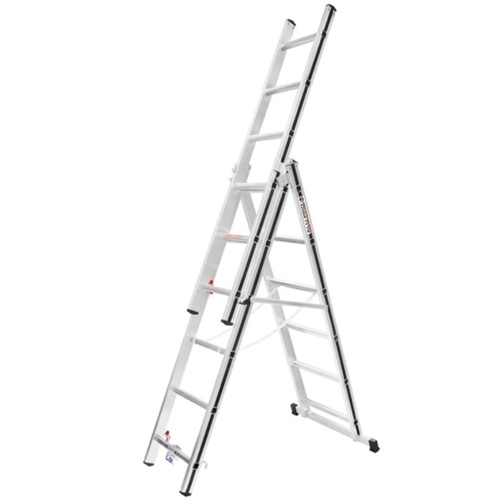
Perhaps a less common style of ladder than the trusty step ladder or classic single section ladders, combination ladders are versatile tools suited to a wide range of tasks. Most valued for their versatility, combination ladders are a popular choice for various tasks around both the home and workplace.
Convenience aside, safety should always remain a primary concern for any ladder user, and thus raises the question – are combination ladders truly safe?
Understanding Combination Ladders
Combination ladders, also commonly known as multi-purpose ladders, are designed to serve multiple functions. They typically feature adjustable configurations, allowing users to set them up as step ladders, extension ladders, or even as work platforms. This adaptability makes them suitable for a wide range of applications, from painting and maintenance to construction projects.
Read more: What is a Combination Ladder
Combination Ladder Safety Features
While some people might find combination ladders daunting due to their complexity or lack of familiarity, the truth is that combination ladders are no more dangerous than any other style of ladder.
Sturdy Construction: High-quality combination ladders are constructed from durable materials such as aluminium or fibreglass, ensuring stability and durability.
Locking Mechanism: Most combination ladders are equipped with locking mechanisms that secure the ladder in its various configurations, preventing accidental collapses or slips.
Non-Slip Feet: To enhance stability, combination ladders are often equipped with non-slip rubber feet that provide traction on different surfaces, reducing the risk of slipping or sliding.
Weight Capacity: It’s essential to check the weight capacity of the ladder and ensure it can support your weight along with any tools or equipment you’ll be using. Exceeding the weight limit can compromise the ladder’s stability and safety.
Safe Combination Ladder Usage Practices:
Here are some top tips for staying safe when using a combination ladder.
Inspection: Before each use, inspect the ladder for any signs of damage or wear, such as cracks, bent rungs, or loose components. Do not use a ladder that appears damaged or compromised in any way.
Proper Setup: Follow the manufacturers instructions for setting up the ladder in the desired configuration. Ensure it is placed on a stable and level surface, and use the locking mechanisms to secure it in place.
Maintain Three Points of Contact: When climbing or descending the ladder, always maintain three points of contact (two hands and one feet, or one hand and two feet) to ensure stability and prevent falls.
Avoid Overreaching: Overreaching while on any ladder, combination ladders included, can throw off your balance and increase the risk of falling. Instead, reposition the ladder as needed to maintain a safe working position.
Safety Instructions: Reputable combination ladders come with clear safety labels and instructions for proper use and set up. It’s crucial to follow these guidelines meticulously to minimise the risk of accidents on injuries.
*
Combination ladders can be safe and effective tools when used correctly and responsibly. By investing in a high-quality ladder and taking the necessary safety precautions during use, you can minimise the risk of accidents and injuries while maximising productivity and efficiency. Remember, safety should always be your top priority when working at height.
Shop Combination Ladders
If you have any further questions about combination ladders, ladder safety, or anything else for that matter, reach out and contact us today. One of our team members will be happy to advise you.
Contact Us

 Ladders
Ladders  Step Ladders
Step Ladders  Loft Ladders
Loft Ladders  Scaffold Towers
Scaffold Towers 








